Unit 4 Don’t eat in class.单元学案(5课时)
文档属性
| 名称 | Unit 4 Don’t eat in class.单元学案(5课时) | 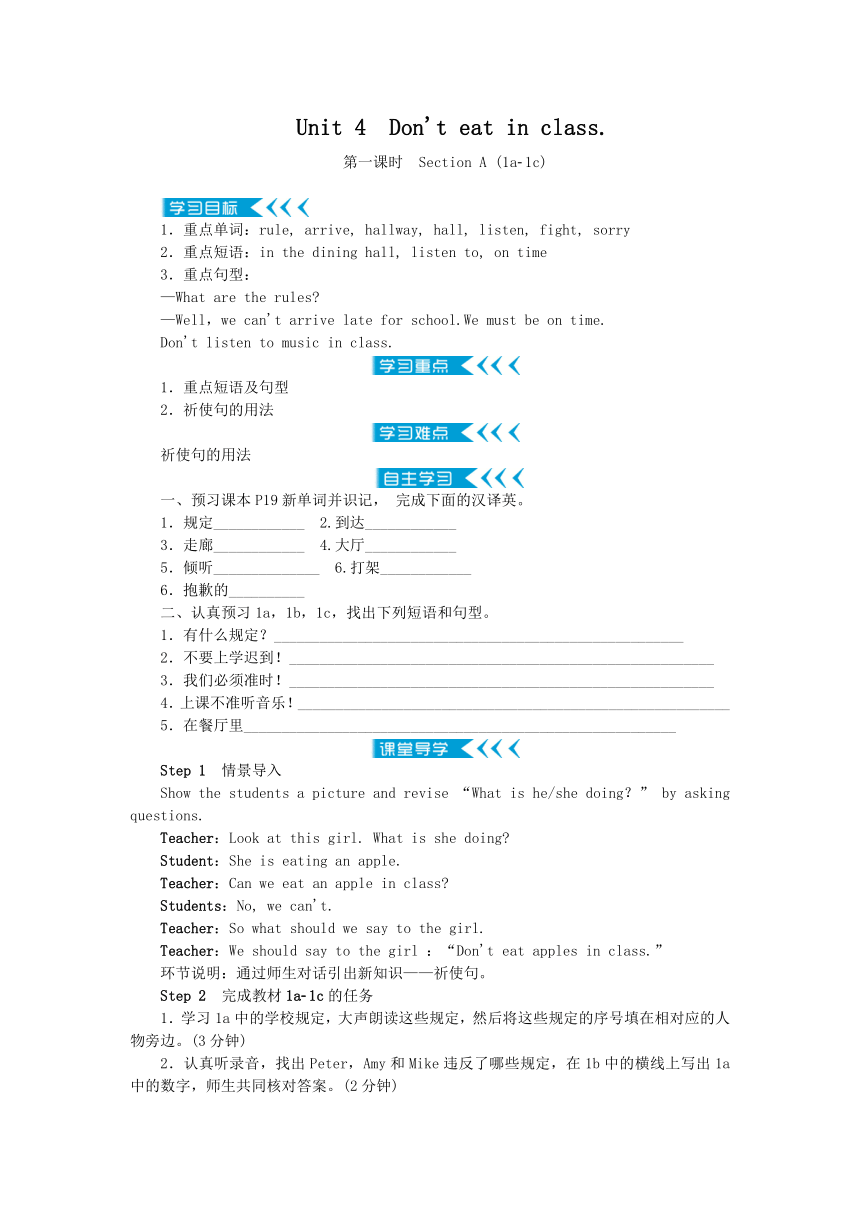 | |
| 格式 | zip | ||
| 文件大小 | 296.4KB | ||
| 资源类型 | 教案 | ||
| 版本资源 | 人教新目标(Go for it)版 | ||
| 科目 | 英语 | ||
| 更新时间 | 2016-05-13 21:41:24 | ||
图片预览

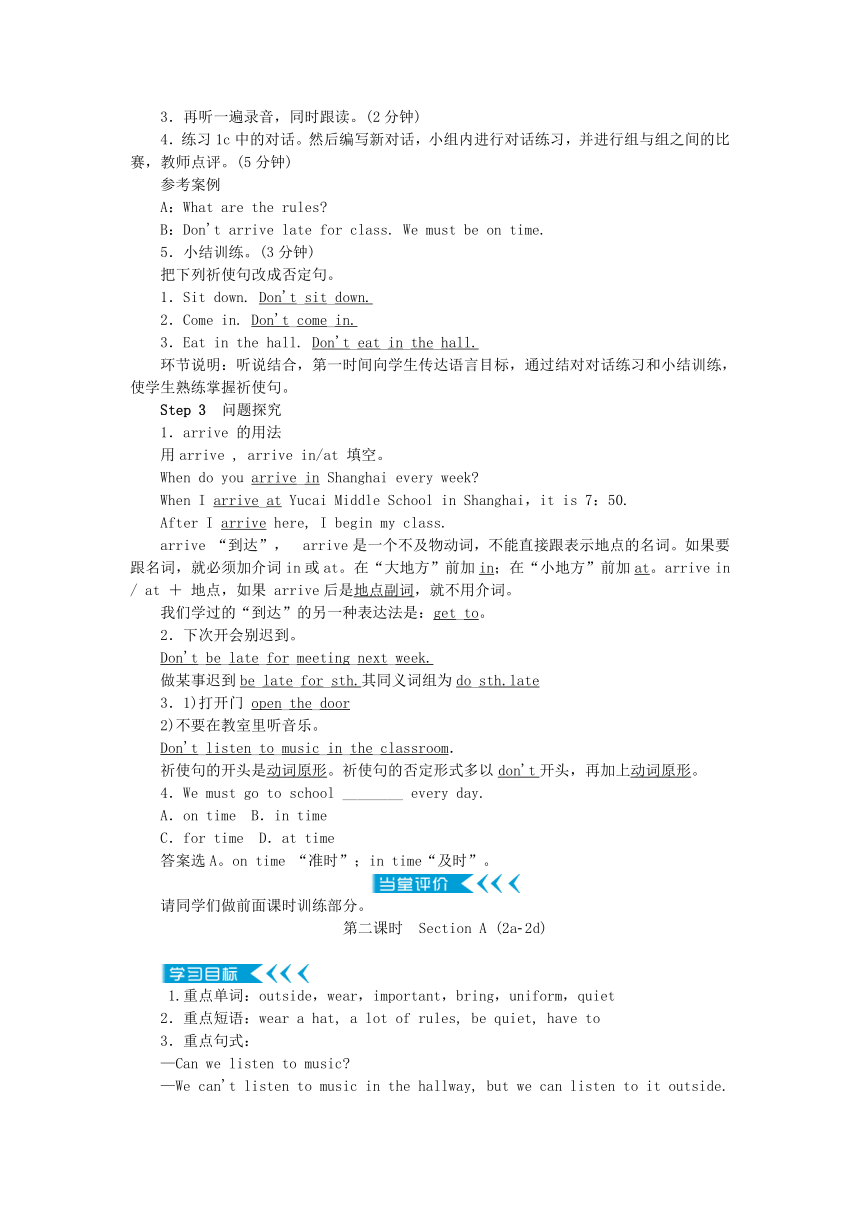
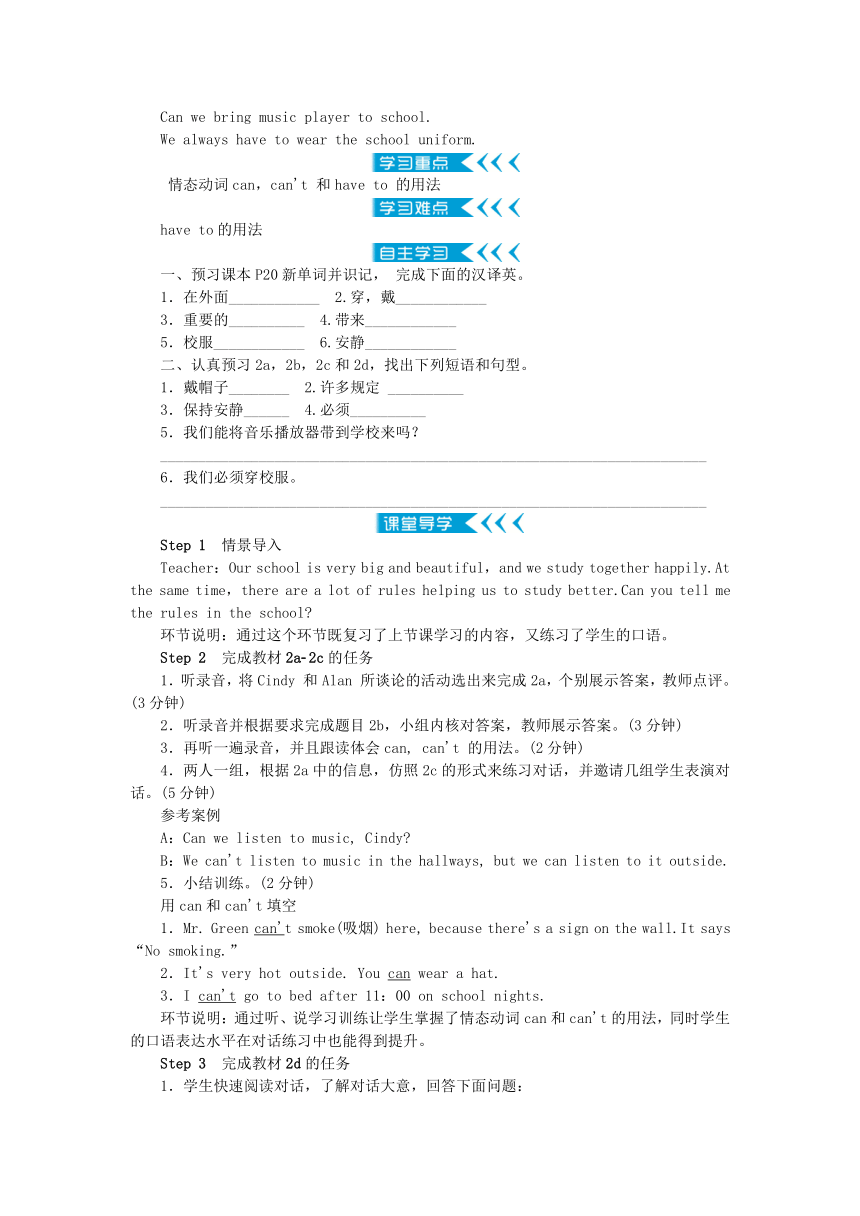
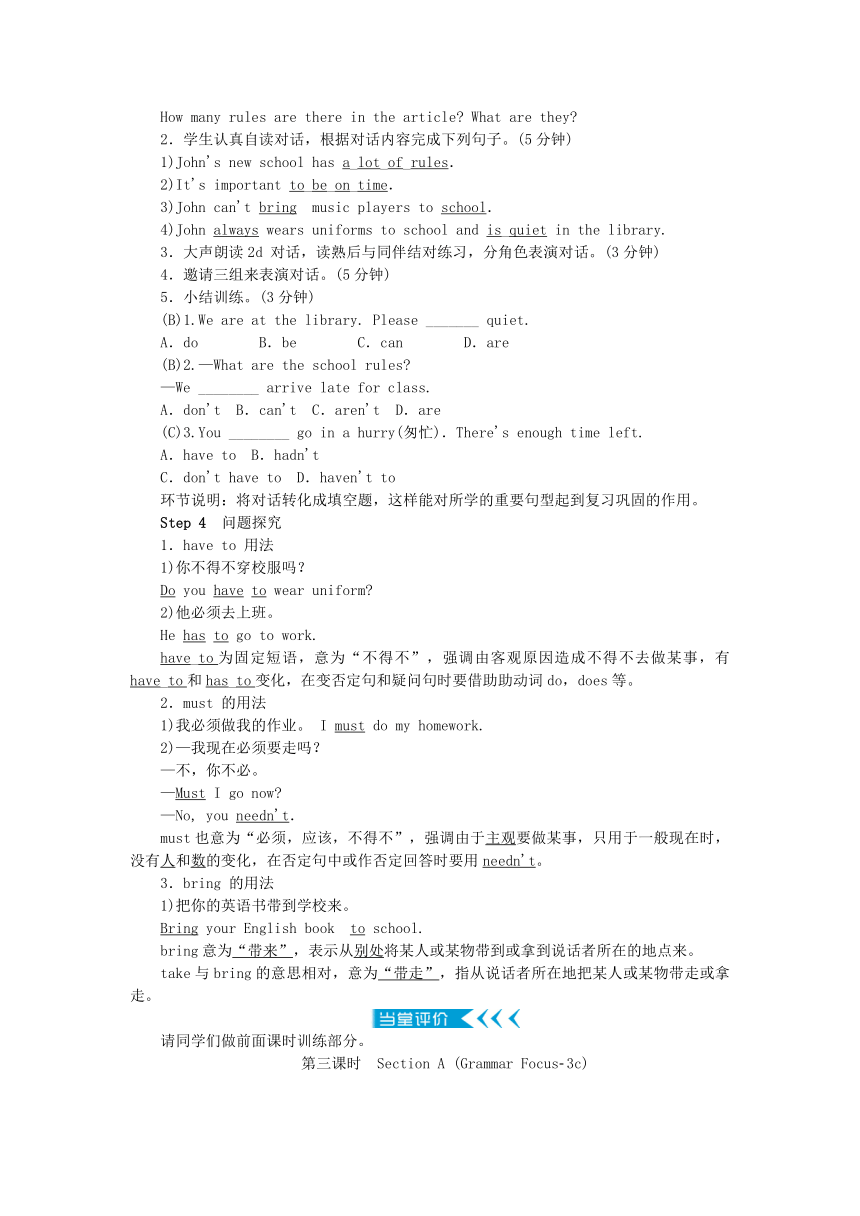
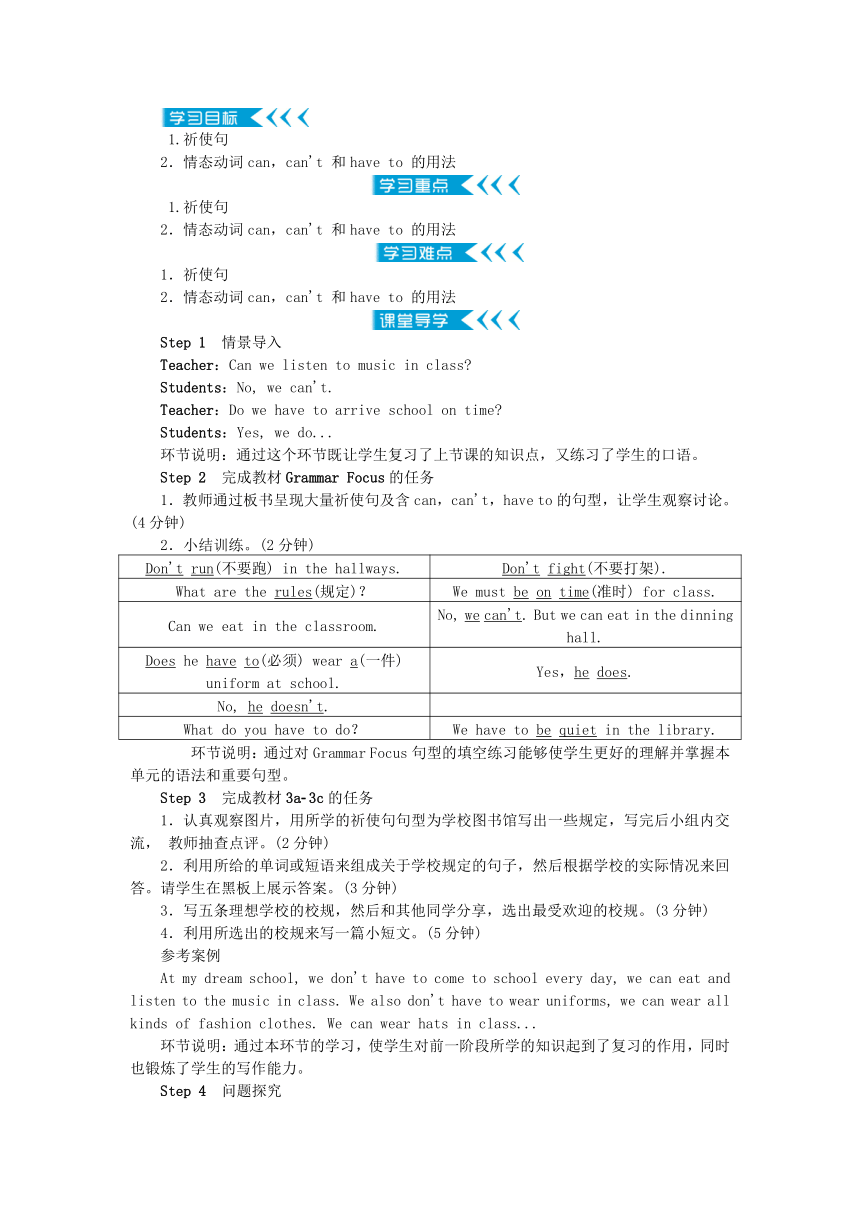
文档简介
Unit 4 Don't eat in class.
第一课时 Section A (1a 1c)
1.重点单词:rule, arrive, hallway, hall, listen, fight, sorry
2.重点短语:in the dining hall, listen to, on time
3.重点句型:
—What are the rules
—Well,we can't arrive late for school.We must be on time.
Don't listen to music in class.
1.重点短语及句型
2.祈使句的用法
祈使句的用法
一、预习课本P19新单词并识记, 完成下面的汉译英。
1.规定____________ 2.到达____________
3.走廊____________ 4.大厅____________
5.倾听______________ 6.打架____________
6.抱歉的__________
二、认真预习1a,1b,1c,找出下列短语和句型。
1.有什么规定?______________________________________________________
2.不要上学迟到!________________________________________________________
3.我们必须准时!________________________________________________________
4.上课不准听音乐!_________________________________________________________
5.在餐厅里_________________________________________________________
Step 1 情景导入
Show the students a picture and revise “What is he/she doing?” by asking questions.
Teacher:Look at this girl. What is she doing
Student:She is eating an apple.
Teacher:Can we eat an apple in class
Students:No, we can't.
Teacher:So what should we say to the girl.
Teacher:We should say to the girl :“Don't eat apples in class.”
环节说明:通过师生对话引出新知识——祈使句。
Step 2 完成教材1a 1c的任务
1.学习1a中的学校规定,大声朗读这些规定,然后将这些规定的序号填在相对应的人物旁边。(3分钟)
2.认真听录音,找出Peter,Amy和Mike违反了哪些规定,在1b中的横线上写出1a中的数字,师生共同核对答案。(2分钟)
3.再听一遍录音,同时跟读。(2分钟)
4.练习1c中的对话。然后编写新对话,小组内进行对话练习,并进行组与组之间的比赛,教师点评。(5分钟)
参考案例
A:What are the rules
B:Don't arrive late for class. We must be on time.
5.小结训练。(3分钟)
把下列祈使句改成否定句。
1.Sit down. Don't_sit_down.
2.Come in. Don't_come_in.
3.Eat in the hall. Don't_eat_in_the_hall.
环节说明:听说结合,第一时间向学生传达语言目标,通过结对对话练习和小结训练,使学生熟练掌握祈使句。
Step 3 问题探究
1.arrive 的用法
用arrive , arrive in/at 填空。
When do you arrive_in Shanghai every week
When I arrive_at Yucai Middle School in Shanghai,it is 7:50.
After I arrive here, I begin my class.
arrive “到达”, arrive是一个不及物动词,不能直接跟表示地点的名词。如果要跟名词,就必须加介词in或at。在“大地方”前加in;在“小地方”前加at。arrive in / at + 地点,如果 arrive后是地点副词,就不用介词。
我们学过的“到达”的另一种表达法是:get_to。
2.下次开会别迟到。
Don't_be_late_for_meeting_next_week.
做某事迟到be_late_for_sth.其同义词组为do_sth.late
3.1)打开门 open_the_door
2)不要在教室里听音乐。
Don't_listen_to_music_in_the_classroom.
祈使句的开头是动词原形。祈使句的否定形式多以don't开头,再加上动词原形。
4.We must go to school ________ every day.
A.on time B.in time
C.for time D.at time
答案选A。on time “准时”;in time“及时”。
请同学们做前面课时训练部分。
第二课时 Section A (2a 2d)
1.重点单词:outside,wear,important,bring,uniform,quiet
2.重点短语:wear a hat, a lot of rules, be quiet, have to
3.重点句式:
—Can we listen to music
—We can't listen to music in the hallway, but we can listen to it outside.
Can we bring music player to school.
We always have to wear the school uniform.
情态动词can,can't 和have to 的用法
have to的用法
一、预习课本P20新单词并识记, 完成下面的汉译英。
1.在外面____________ 2.穿,戴____________
3.重要的__________ 4.带来____________
5.校服____________ 6.安静____________
二、认真预习2a,2b,2c和2d,找出下列短语和句型。
1.戴帽子________ 2.许多规定 __________
3.保持安静______ 4.必须__________
5.我们能将音乐播放器带到学校来吗?
________________________________________________________________________
6.我们必须穿校服。
________________________________________________________________________
Step 1 情景导入
Teacher:Our school is very big and beautiful,and we study together happily.At the same time,there are a lot of rules helping us to study better.Can you tell me the rules in the school
环节说明:通过这个环节既复习了上节课学习的内容,又练习了学生的口语。
Step 2 完成教材2a 2c的任务
1.听录音,将Cindy 和Alan 所谈论的活动选出来完成2a,个别展示答案,教师点评。(3分钟)
2.听录音并根据要求完成题目2b,小组内核对答案,教师展示答案。(3分钟)
3.再听一遍录音,并且跟读体会can, can't 的用法。(2分钟)
4.两人一组,根据2a中的信息,仿照2c的形式来练习对话,并邀请几组学生表演对话。(5分钟)
参考案例
A:Can we listen to music, Cindy
B:We can't listen to music in the hallways, but we can listen to it outside.
5.小结训练。(2分钟)
用can和can't填空
1.Mr. Green can't smoke(吸烟) here, because there's a sign on the wall.It says “No smoking.”
2.It's very hot outside. You can wear a hat.
3.I can't go to bed after 11:00 on school nights.
环节说明:通过听、说学习训练让学生掌握了情态动词can和can't的用法,同时学生的口语表达水平在对话练习中也能得到提升。
Step 3 完成教材2d的任务
1.学生快速阅读对话,了解对话大意,回答下面问题:
How many rules are there in the article What are they
2.学生认真自读对话,根据对话内容完成下列句子。(5分钟)
1)John's new school has a_lot_of_rules.
2)It's important to_be_on_time.
3)John can't bring music players to school.
4)John always wears uniforms to school and is_quiet in the library.
3.大声朗读2d 对话,读熟后与同伴结对练习,分角色表演对话。(3分钟)
4.邀请三组来表演对话。(5分钟)
5.小结训练。(3分钟)
(B)1.We are at the library. Please _______ quiet.
A.do B.be C.can D.are
(B)2.—What are the school rules
—We ________ arrive late for class.
A.don't B.can't C.aren't D.are
(C)3.You ________ go in a hurry(匆忙).There's enough time left.
A.have to B.hadn't
C.don't have to D.haven't to
环节说明:将对话转化成填空题,这样能对所学的重要句型起到复习巩固的作用。
Step 4 问题探究
1.have to 用法
1)你不得不穿校服吗?
Do you have to wear uniform
2)他必须去上班。
He has to go to work.
have_to为固定短语,意为“不得不”,强调由客观原因造成不得不去做某事,有have_to和has_to变化,在变否定句和疑问句时要借助助动词do,does等。
2.must 的用法
1)我必须做我的作业。 I must do my homework.
2)—我现在必须要走吗?
—不,你不必。
—Must I go now
—No, you needn't.
must也意为“必须,应该,不得不”,强调由于主观要做某事,只用于一般现在时,没有人和数的变化,在否定句中或作否定回答时要用needn't。
3.bring 的用法
1)把你的英语书带到学校来。
Bring your English book to school.
bring意为“带来”,表示从别处将某人或某物带到或拿到说话者所在的地点来。
take与bring的意思相对,意为“带走”,指从说话者所在地把某人或某物带走或拿走。
请同学们做前面课时训练部分。
第三课时 Section A (Grammar Focus 3c)
1.祈使句
2.情态动词can,can't 和have to 的用法
1.祈使句
2.情态动词can,can't 和have to 的用法
1.祈使句
2.情态动词can,can't 和have to 的用法
Step 1 情景导入
Teacher:Can we listen to music in class
Students:No, we can't.
Teacher:Do we have to arrive school on time
Students:Yes, we do...
环节说明:通过这个环节既让学生复习了上节课的知识点,又练习了学生的口语。
Step 2 完成教材Grammar Focus的任务
1.教师通过板书呈现大量祈使句及含can,can't,have to的句型,让学生观察讨论。(4分钟)
2.小结训练。(2分钟)
Don't run(不要跑) in the hallways. Don't fight(不要打架).
What are the rules(规定)? We must be on time(准时) for class.
Can we eat in the classroom. No, we can't. But we can eat in the dinning hall.
Does he have to(必须) wear a(一件) uniform at school. Yes,he does.
No, he doesn't.
What do you have to do? We have to be quiet in the library.
环节说明:通过对Grammar Focus句型的填空练习能够使学生更好的理解并掌握本单元的语法和重要句型。
Step 3 完成教材3a 3c的任务
1.认真观察图片,用所学的祈使句句型为学校图书馆写出一些规定,写完后小组内交流, 教师抽查点评。(2分钟)
2.利用所给的单词或短语来组成关于学校规定的句子,然后根据学校的实际情况来回答。请学生在黑板上展示答案。(3分钟)
3.写五条理想学校的校规,然后和其他同学分享,选出最受欢迎的校规。(3分钟)
4.利用所选出的校规来写一篇小短文。(5分钟)
参考案例
At my dream school, we don't have to come to school every day, we can eat and listen to the music in class. We also don't have to wear uniforms, we can wear all kinds of fashion clothes. We can wear hats in class...
环节说明:通过本环节的学习,使学生对前一阶段所学的知识起到了复习的作用,同时也锻炼了学生的写作能力。
Step 4 问题探究
1.fight的用法
1)The boy often fights ________ others.
A.with B.for C.in D.to
答案选A。fight 动词,常用词组fight with....与……争斗/打架。fight 还可以作为名词,常用于词组have a fight with...中。
请同学们做前面课时训练部分。
第四课时 Section B (1a 1d)
1.重点单词:out,practice,dish,night,before
2.重点短语:go out,see friends,practice the piano,do the dishes,on school nights
情态动词can,can't 和have to 的用法
情态动词can,can't 和have to 的用法
一、预习课本P22新单词并识记, 完成下面的汉译英。
1.外出__________ 2.练习__________
3.碟____________ 4.在……以前__________
二、认真预习1a,1b,1c和1d,找出下列短语。
1.出去____________ 2.洗餐具__________
3.看望朋友________ 4.做早餐__________
5.在上学的晚上_________________________________________________
Step 1 情景导入
Dave is a student,he is a boy.At school,he has many school rules to follow.And at home he also has many rules.What are the rules at Dave's home.Do you want to know?Let's learn together and you will find the answer.
环节说明:通过设置悬念,引起学生的学习兴趣,导入本课的学习。
Step 2 完成教材1a 1d的任务
1.先让学生仔细看1a中的图片,教师并用句型“What is he/she doing?”提问。然后指出这些制度,教师领读。最后将1b中的短语和1a中的图片匹配,并核对答案。(5分钟)
2.听录音标出Dave不能做的事情和他必须要做的事情,集体核对答案,完成1b。(2分钟)
3.记忆1c中的短语,然后听录音从1c中选出Dave遵守1b中这些规定的时间。(5分钟)
4.两人一组仿照1d的对话形式练习对话,结合实际谈论自己的家规。最后请学生做简短的报告。(5分钟)
参考案例
A:Can you go out on school nights
B:No, I can't.
5.小结训练。(2分钟)
(C)1.—Why are you walking so fast
—Because I ________ get home to do my work.
A.have B.go to C.have to D.has to
(B)2.—Can you cook dinner
—________.It's easy.
A.No, I can't B.Yes, I can
C.No, I can D.Yes, I need
(A)3.I can't watch TV ________ my school nights.
A.on B.at C.in D.to
环节说明:通过本环节的学习使学生熟练地掌握情态动词can,can't 和have to的用法, 并且为谈论自己的家规奠定了基础。
Step 4 问题探究
1.practice 的用法
1)练习吉他 practice_the_guitar
2)练习弹吉他 practice_playing_the_guitar
practice 意为“练习,实践”。它的后面可以跟名词或代词,如果跟动词要把动词变成ing形式。
2.1)在上学期间的晚上 at_school_nights
night前若有其他词汇修饰,指具体的某个晚上,应用介词on。
请同学们做前面课时训练部分。
第五课时 Section B (2a) Self Check
1.重点单词:dirty,kitchen,more,noisy,relax,read,terrible,feel,strict,remember,follow,luck,keep,hair,learn
2.重点短语:too many,make your bed,keep my hair short,be strict with sb,follow the rules,make rules,good luck
3.重点句式:There are too many rules at home.
Don't leave the dirty dishes in the kitchen.
I must read a book before I can watch TV.
1.重点单词、短语和句型
2.情态动词can,can't 和have to 的用法
1.重点单词、短语和句型
一、预习课本P23-24新单词并识记, 完成下面的汉译英。
1.脏的____________ 2.厨房____________
3.更多的__________ 4.吵闹的__________
5.放松____________ 6.阅读____________
7.可怕的__________ 8.感觉____________
9.严格的__________ 10.记住____________
11.遵循____________ 12.运气____________
13.保持____________ 14.头发____________
15.学习____________
二、认真预习2a,2b,2c,3a和Self Check内容,找出下列短语和句型。
1.读书___________ 2.整理床铺___________
3.好运___________ 4.留短发_____________
5.对某人要求严格_________________________________________
6.遵守规定_________________________________________________
7.在家里有许多的规定。______________________________________________________
8.不要把脏盘子留在厨房里。
________________________________________________________________________
9.我在能看电视之前必须要读书。
________________________________________________________________________
Step 1 情景导入
Teacher:When you are unhappy about something,who do you like to talk to,your parents,your teachers or your friends?Can you tell me
Students:...
Teacher:Molly is a student like us.She is very upset.Do you know why she is unhappy,and who she likes to talk to
环节说明:通过情景导入即完成了2a的学习又引出了Molly的烦恼,引起学生的好奇心,激发了他们的学习欲望。
Step 2 完成教材2b 2c的任务
1.快速阅读2b信件,了解信件内容,画出Molly 的家规。(2分钟)
2.再次认真阅读信件,回答下面的问题。(3分钟)
1)Are there many rules at Molly's home
2)How does Molly go to school
3)Does Molly never play basketball
4)When does she have to go to bed
3.第三遍阅读短文完成2c的选词填空。
4.小结训练。(2分钟)
(A)1.There are ________ people in the shopping center on Sundays.
A.too many B.too much C.much D.a lot
(A)2.Please don't make so much ______, it's too______.
A.noise, noisy B.noisy, noisy
C.noise, noise D.noisy, noise
(B)3.The girl is ________ to catch the early bus to work.
A.luck B.lucky C.luckily D.lucks
(C)4.Mr. Zhang is our English teacher, he is very strict ________ us and ________ his work.
A.in, in B.with, with
C.with, in D.in, with
环节说明:通过这一环节的学习不仅巩固了本单元的语法,而且还锻炼了学生阅读能力和概括能力。
Step 3 完成教材3a 3c的任务
1.请同学们读3a的短文,然后从方框中选词将短文补充完整,集体核对答案。(3分钟)
2.大声朗读3a 短文。(2分钟)
3.写出你在家里和学校必须要做的事情和不能做的事情,完成表格,并标出你认为最不公平的规定。(3分钟)
4.根据3b中的表格内容,给Dr.Know 写一封信,告诉他你家和学校的规定以及你的感受。(5分钟)
参考案例
Dear Dr. Know,
There are many rules at home and school. I have to get up at six o'clock in the morning. After breakfast, I have to go to school quickly, because I can't arrive late for school. In class I must listen to the teacher carefully. At school we can't listen to music and eat lunch in the classroom. After school I can't play with my classmates. I must do my homework first. After supper I have to read a book for half an hour. I can't watch TV on school nights.
环节说明:这一环节通过读写的训练,有助于学生写作水平的提高,巩固所学的知识。
Step 4 完成教材Self Check的任务
1.认真识记Self Check 1 表格中的词组,然后用所给的词组来完成短文填空。小组交流,教师核对答案。(3分钟)
2.运用can, can't, have to, must和don't来写出学校的规定,每个规定用两种方法来写。 (2分钟)
3.小结训练。(2分钟)
1.I can sing this song in English. (改为否定句)
I_can't_sing_this_song_in_English.
2.Eat food in the classroom. (改为否定句)
Don't_eat_food_in_the_classroom.
3.He has to do his homework at school. (改为否定句)
He_doesn't_have_to_do_his_homework_at_school.
4.You can watch TV after supper. (改为祈使句)
Don't_watch_TV_after_supper.
Step 5 问题探究
1.too many, too much 的用法
1)太多的苹果 too_many_apples
2)太多的水 too_much_water
many一般修饰可数名词复数,表示“许多的”,前面加副词too,则表示“太多的”。too much后要跟不可数名词。much一般修饰不可数名词,too much后要跟不可数名词。
2.noise与noisy的用法
1)Please don't make much noise.It's too noisy.
noise是不可数名词;noisy 是形容词。
3.leave 的用法
1)离开中国 leave_China
2)把我的作业忘在了家里 leave_my_homework_at_home
leave 意为“离开,遗忘”。
离开某地 leave_+地点
把某物忘在了某地 leave_+sth.+地点
4.read 的用法
1)看书 read_books
2)看报纸 read_newspapers
read意为“看,读”,指看有文字内容的东西, 后面常跟书刊、 报纸和杂志等单词。
5.strict 的用法
1)这个老师对学生要求严格。
The_teacher_is_strict_with_students.
2)这个老师对工作要求严格。
The_teacher_is_strict_in_work.
strict意为“严格”,经常用到的句型有:对某人要求严格be_strict_with_sb.;对某事要求严格be_strict_in_sth.。
6.Can you keep the classroom ________.
A.clean B.cleans
C.cleaning D.to clean
答案选A。“keep+宾语+ 形容词”意为“保持某物某种状态”。
请同学们做前面课时训练部分。
第一课时 Section A (1a 1c)
1.重点单词:rule, arrive, hallway, hall, listen, fight, sorry
2.重点短语:in the dining hall, listen to, on time
3.重点句型:
—What are the rules
—Well,we can't arrive late for school.We must be on time.
Don't listen to music in class.
1.重点短语及句型
2.祈使句的用法
祈使句的用法
一、预习课本P19新单词并识记, 完成下面的汉译英。
1.规定____________ 2.到达____________
3.走廊____________ 4.大厅____________
5.倾听______________ 6.打架____________
6.抱歉的__________
二、认真预习1a,1b,1c,找出下列短语和句型。
1.有什么规定?______________________________________________________
2.不要上学迟到!________________________________________________________
3.我们必须准时!________________________________________________________
4.上课不准听音乐!_________________________________________________________
5.在餐厅里_________________________________________________________
Step 1 情景导入
Show the students a picture and revise “What is he/she doing?” by asking questions.
Teacher:Look at this girl. What is she doing
Student:She is eating an apple.
Teacher:Can we eat an apple in class
Students:No, we can't.
Teacher:So what should we say to the girl.
Teacher:We should say to the girl :“Don't eat apples in class.”
环节说明:通过师生对话引出新知识——祈使句。
Step 2 完成教材1a 1c的任务
1.学习1a中的学校规定,大声朗读这些规定,然后将这些规定的序号填在相对应的人物旁边。(3分钟)
2.认真听录音,找出Peter,Amy和Mike违反了哪些规定,在1b中的横线上写出1a中的数字,师生共同核对答案。(2分钟)
3.再听一遍录音,同时跟读。(2分钟)
4.练习1c中的对话。然后编写新对话,小组内进行对话练习,并进行组与组之间的比赛,教师点评。(5分钟)
参考案例
A:What are the rules
B:Don't arrive late for class. We must be on time.
5.小结训练。(3分钟)
把下列祈使句改成否定句。
1.Sit down. Don't_sit_down.
2.Come in. Don't_come_in.
3.Eat in the hall. Don't_eat_in_the_hall.
环节说明:听说结合,第一时间向学生传达语言目标,通过结对对话练习和小结训练,使学生熟练掌握祈使句。
Step 3 问题探究
1.arrive 的用法
用arrive , arrive in/at 填空。
When do you arrive_in Shanghai every week
When I arrive_at Yucai Middle School in Shanghai,it is 7:50.
After I arrive here, I begin my class.
arrive “到达”, arrive是一个不及物动词,不能直接跟表示地点的名词。如果要跟名词,就必须加介词in或at。在“大地方”前加in;在“小地方”前加at。arrive in / at + 地点,如果 arrive后是地点副词,就不用介词。
我们学过的“到达”的另一种表达法是:get_to。
2.下次开会别迟到。
Don't_be_late_for_meeting_next_week.
做某事迟到be_late_for_sth.其同义词组为do_sth.late
3.1)打开门 open_the_door
2)不要在教室里听音乐。
Don't_listen_to_music_in_the_classroom.
祈使句的开头是动词原形。祈使句的否定形式多以don't开头,再加上动词原形。
4.We must go to school ________ every day.
A.on time B.in time
C.for time D.at time
答案选A。on time “准时”;in time“及时”。
请同学们做前面课时训练部分。
第二课时 Section A (2a 2d)
1.重点单词:outside,wear,important,bring,uniform,quiet
2.重点短语:wear a hat, a lot of rules, be quiet, have to
3.重点句式:
—Can we listen to music
—We can't listen to music in the hallway, but we can listen to it outside.
Can we bring music player to school.
We always have to wear the school uniform.
情态动词can,can't 和have to 的用法
have to的用法
一、预习课本P20新单词并识记, 完成下面的汉译英。
1.在外面____________ 2.穿,戴____________
3.重要的__________ 4.带来____________
5.校服____________ 6.安静____________
二、认真预习2a,2b,2c和2d,找出下列短语和句型。
1.戴帽子________ 2.许多规定 __________
3.保持安静______ 4.必须__________
5.我们能将音乐播放器带到学校来吗?
________________________________________________________________________
6.我们必须穿校服。
________________________________________________________________________
Step 1 情景导入
Teacher:Our school is very big and beautiful,and we study together happily.At the same time,there are a lot of rules helping us to study better.Can you tell me the rules in the school
环节说明:通过这个环节既复习了上节课学习的内容,又练习了学生的口语。
Step 2 完成教材2a 2c的任务
1.听录音,将Cindy 和Alan 所谈论的活动选出来完成2a,个别展示答案,教师点评。(3分钟)
2.听录音并根据要求完成题目2b,小组内核对答案,教师展示答案。(3分钟)
3.再听一遍录音,并且跟读体会can, can't 的用法。(2分钟)
4.两人一组,根据2a中的信息,仿照2c的形式来练习对话,并邀请几组学生表演对话。(5分钟)
参考案例
A:Can we listen to music, Cindy
B:We can't listen to music in the hallways, but we can listen to it outside.
5.小结训练。(2分钟)
用can和can't填空
1.Mr. Green can't smoke(吸烟) here, because there's a sign on the wall.It says “No smoking.”
2.It's very hot outside. You can wear a hat.
3.I can't go to bed after 11:00 on school nights.
环节说明:通过听、说学习训练让学生掌握了情态动词can和can't的用法,同时学生的口语表达水平在对话练习中也能得到提升。
Step 3 完成教材2d的任务
1.学生快速阅读对话,了解对话大意,回答下面问题:
How many rules are there in the article What are they
2.学生认真自读对话,根据对话内容完成下列句子。(5分钟)
1)John's new school has a_lot_of_rules.
2)It's important to_be_on_time.
3)John can't bring music players to school.
4)John always wears uniforms to school and is_quiet in the library.
3.大声朗读2d 对话,读熟后与同伴结对练习,分角色表演对话。(3分钟)
4.邀请三组来表演对话。(5分钟)
5.小结训练。(3分钟)
(B)1.We are at the library. Please _______ quiet.
A.do B.be C.can D.are
(B)2.—What are the school rules
—We ________ arrive late for class.
A.don't B.can't C.aren't D.are
(C)3.You ________ go in a hurry(匆忙).There's enough time left.
A.have to B.hadn't
C.don't have to D.haven't to
环节说明:将对话转化成填空题,这样能对所学的重要句型起到复习巩固的作用。
Step 4 问题探究
1.have to 用法
1)你不得不穿校服吗?
Do you have to wear uniform
2)他必须去上班。
He has to go to work.
have_to为固定短语,意为“不得不”,强调由客观原因造成不得不去做某事,有have_to和has_to变化,在变否定句和疑问句时要借助助动词do,does等。
2.must 的用法
1)我必须做我的作业。 I must do my homework.
2)—我现在必须要走吗?
—不,你不必。
—Must I go now
—No, you needn't.
must也意为“必须,应该,不得不”,强调由于主观要做某事,只用于一般现在时,没有人和数的变化,在否定句中或作否定回答时要用needn't。
3.bring 的用法
1)把你的英语书带到学校来。
Bring your English book to school.
bring意为“带来”,表示从别处将某人或某物带到或拿到说话者所在的地点来。
take与bring的意思相对,意为“带走”,指从说话者所在地把某人或某物带走或拿走。
请同学们做前面课时训练部分。
第三课时 Section A (Grammar Focus 3c)
1.祈使句
2.情态动词can,can't 和have to 的用法
1.祈使句
2.情态动词can,can't 和have to 的用法
1.祈使句
2.情态动词can,can't 和have to 的用法
Step 1 情景导入
Teacher:Can we listen to music in class
Students:No, we can't.
Teacher:Do we have to arrive school on time
Students:Yes, we do...
环节说明:通过这个环节既让学生复习了上节课的知识点,又练习了学生的口语。
Step 2 完成教材Grammar Focus的任务
1.教师通过板书呈现大量祈使句及含can,can't,have to的句型,让学生观察讨论。(4分钟)
2.小结训练。(2分钟)
Don't run(不要跑) in the hallways. Don't fight(不要打架).
What are the rules(规定)? We must be on time(准时) for class.
Can we eat in the classroom. No, we can't. But we can eat in the dinning hall.
Does he have to(必须) wear a(一件) uniform at school. Yes,he does.
No, he doesn't.
What do you have to do? We have to be quiet in the library.
环节说明:通过对Grammar Focus句型的填空练习能够使学生更好的理解并掌握本单元的语法和重要句型。
Step 3 完成教材3a 3c的任务
1.认真观察图片,用所学的祈使句句型为学校图书馆写出一些规定,写完后小组内交流, 教师抽查点评。(2分钟)
2.利用所给的单词或短语来组成关于学校规定的句子,然后根据学校的实际情况来回答。请学生在黑板上展示答案。(3分钟)
3.写五条理想学校的校规,然后和其他同学分享,选出最受欢迎的校规。(3分钟)
4.利用所选出的校规来写一篇小短文。(5分钟)
参考案例
At my dream school, we don't have to come to school every day, we can eat and listen to the music in class. We also don't have to wear uniforms, we can wear all kinds of fashion clothes. We can wear hats in class...
环节说明:通过本环节的学习,使学生对前一阶段所学的知识起到了复习的作用,同时也锻炼了学生的写作能力。
Step 4 问题探究
1.fight的用法
1)The boy often fights ________ others.
A.with B.for C.in D.to
答案选A。fight 动词,常用词组fight with....与……争斗/打架。fight 还可以作为名词,常用于词组have a fight with...中。
请同学们做前面课时训练部分。
第四课时 Section B (1a 1d)
1.重点单词:out,practice,dish,night,before
2.重点短语:go out,see friends,practice the piano,do the dishes,on school nights
情态动词can,can't 和have to 的用法
情态动词can,can't 和have to 的用法
一、预习课本P22新单词并识记, 完成下面的汉译英。
1.外出__________ 2.练习__________
3.碟____________ 4.在……以前__________
二、认真预习1a,1b,1c和1d,找出下列短语。
1.出去____________ 2.洗餐具__________
3.看望朋友________ 4.做早餐__________
5.在上学的晚上_________________________________________________
Step 1 情景导入
Dave is a student,he is a boy.At school,he has many school rules to follow.And at home he also has many rules.What are the rules at Dave's home.Do you want to know?Let's learn together and you will find the answer.
环节说明:通过设置悬念,引起学生的学习兴趣,导入本课的学习。
Step 2 完成教材1a 1d的任务
1.先让学生仔细看1a中的图片,教师并用句型“What is he/she doing?”提问。然后指出这些制度,教师领读。最后将1b中的短语和1a中的图片匹配,并核对答案。(5分钟)
2.听录音标出Dave不能做的事情和他必须要做的事情,集体核对答案,完成1b。(2分钟)
3.记忆1c中的短语,然后听录音从1c中选出Dave遵守1b中这些规定的时间。(5分钟)
4.两人一组仿照1d的对话形式练习对话,结合实际谈论自己的家规。最后请学生做简短的报告。(5分钟)
参考案例
A:Can you go out on school nights
B:No, I can't.
5.小结训练。(2分钟)
(C)1.—Why are you walking so fast
—Because I ________ get home to do my work.
A.have B.go to C.have to D.has to
(B)2.—Can you cook dinner
—________.It's easy.
A.No, I can't B.Yes, I can
C.No, I can D.Yes, I need
(A)3.I can't watch TV ________ my school nights.
A.on B.at C.in D.to
环节说明:通过本环节的学习使学生熟练地掌握情态动词can,can't 和have to的用法, 并且为谈论自己的家规奠定了基础。
Step 4 问题探究
1.practice 的用法
1)练习吉他 practice_the_guitar
2)练习弹吉他 practice_playing_the_guitar
practice 意为“练习,实践”。它的后面可以跟名词或代词,如果跟动词要把动词变成ing形式。
2.1)在上学期间的晚上 at_school_nights
night前若有其他词汇修饰,指具体的某个晚上,应用介词on。
请同学们做前面课时训练部分。
第五课时 Section B (2a) Self Check
1.重点单词:dirty,kitchen,more,noisy,relax,read,terrible,feel,strict,remember,follow,luck,keep,hair,learn
2.重点短语:too many,make your bed,keep my hair short,be strict with sb,follow the rules,make rules,good luck
3.重点句式:There are too many rules at home.
Don't leave the dirty dishes in the kitchen.
I must read a book before I can watch TV.
1.重点单词、短语和句型
2.情态动词can,can't 和have to 的用法
1.重点单词、短语和句型
一、预习课本P23-24新单词并识记, 完成下面的汉译英。
1.脏的____________ 2.厨房____________
3.更多的__________ 4.吵闹的__________
5.放松____________ 6.阅读____________
7.可怕的__________ 8.感觉____________
9.严格的__________ 10.记住____________
11.遵循____________ 12.运气____________
13.保持____________ 14.头发____________
15.学习____________
二、认真预习2a,2b,2c,3a和Self Check内容,找出下列短语和句型。
1.读书___________ 2.整理床铺___________
3.好运___________ 4.留短发_____________
5.对某人要求严格_________________________________________
6.遵守规定_________________________________________________
7.在家里有许多的规定。______________________________________________________
8.不要把脏盘子留在厨房里。
________________________________________________________________________
9.我在能看电视之前必须要读书。
________________________________________________________________________
Step 1 情景导入
Teacher:When you are unhappy about something,who do you like to talk to,your parents,your teachers or your friends?Can you tell me
Students:...
Teacher:Molly is a student like us.She is very upset.Do you know why she is unhappy,and who she likes to talk to
环节说明:通过情景导入即完成了2a的学习又引出了Molly的烦恼,引起学生的好奇心,激发了他们的学习欲望。
Step 2 完成教材2b 2c的任务
1.快速阅读2b信件,了解信件内容,画出Molly 的家规。(2分钟)
2.再次认真阅读信件,回答下面的问题。(3分钟)
1)Are there many rules at Molly's home
2)How does Molly go to school
3)Does Molly never play basketball
4)When does she have to go to bed
3.第三遍阅读短文完成2c的选词填空。
4.小结训练。(2分钟)
(A)1.There are ________ people in the shopping center on Sundays.
A.too many B.too much C.much D.a lot
(A)2.Please don't make so much ______, it's too______.
A.noise, noisy B.noisy, noisy
C.noise, noise D.noisy, noise
(B)3.The girl is ________ to catch the early bus to work.
A.luck B.lucky C.luckily D.lucks
(C)4.Mr. Zhang is our English teacher, he is very strict ________ us and ________ his work.
A.in, in B.with, with
C.with, in D.in, with
环节说明:通过这一环节的学习不仅巩固了本单元的语法,而且还锻炼了学生阅读能力和概括能力。
Step 3 完成教材3a 3c的任务
1.请同学们读3a的短文,然后从方框中选词将短文补充完整,集体核对答案。(3分钟)
2.大声朗读3a 短文。(2分钟)
3.写出你在家里和学校必须要做的事情和不能做的事情,完成表格,并标出你认为最不公平的规定。(3分钟)
4.根据3b中的表格内容,给Dr.Know 写一封信,告诉他你家和学校的规定以及你的感受。(5分钟)
参考案例
Dear Dr. Know,
There are many rules at home and school. I have to get up at six o'clock in the morning. After breakfast, I have to go to school quickly, because I can't arrive late for school. In class I must listen to the teacher carefully. At school we can't listen to music and eat lunch in the classroom. After school I can't play with my classmates. I must do my homework first. After supper I have to read a book for half an hour. I can't watch TV on school nights.
环节说明:这一环节通过读写的训练,有助于学生写作水平的提高,巩固所学的知识。
Step 4 完成教材Self Check的任务
1.认真识记Self Check 1 表格中的词组,然后用所给的词组来完成短文填空。小组交流,教师核对答案。(3分钟)
2.运用can, can't, have to, must和don't来写出学校的规定,每个规定用两种方法来写。 (2分钟)
3.小结训练。(2分钟)
1.I can sing this song in English. (改为否定句)
I_can't_sing_this_song_in_English.
2.Eat food in the classroom. (改为否定句)
Don't_eat_food_in_the_classroom.
3.He has to do his homework at school. (改为否定句)
He_doesn't_have_to_do_his_homework_at_school.
4.You can watch TV after supper. (改为祈使句)
Don't_watch_TV_after_supper.
Step 5 问题探究
1.too many, too much 的用法
1)太多的苹果 too_many_apples
2)太多的水 too_much_water
many一般修饰可数名词复数,表示“许多的”,前面加副词too,则表示“太多的”。too much后要跟不可数名词。much一般修饰不可数名词,too much后要跟不可数名词。
2.noise与noisy的用法
1)Please don't make much noise.It's too noisy.
noise是不可数名词;noisy 是形容词。
3.leave 的用法
1)离开中国 leave_China
2)把我的作业忘在了家里 leave_my_homework_at_home
leave 意为“离开,遗忘”。
离开某地 leave_+地点
把某物忘在了某地 leave_+sth.+地点
4.read 的用法
1)看书 read_books
2)看报纸 read_newspapers
read意为“看,读”,指看有文字内容的东西, 后面常跟书刊、 报纸和杂志等单词。
5.strict 的用法
1)这个老师对学生要求严格。
The_teacher_is_strict_with_students.
2)这个老师对工作要求严格。
The_teacher_is_strict_in_work.
strict意为“严格”,经常用到的句型有:对某人要求严格be_strict_with_sb.;对某事要求严格be_strict_in_sth.。
6.Can you keep the classroom ________.
A.clean B.cleans
C.cleaning D.to clean
答案选A。“keep+宾语+ 形容词”意为“保持某物某种状态”。
请同学们做前面课时训练部分。
同课章节目录
- Unit 1 Can you play the guitar?
- Section A
- Section B
- Unit 2 What time do you go to school?
- Section A
- Section B
- Unit 3 How do you get to school?
- Section A
- Section B
- Unit 4 Don't eat in class.
- Section A
- Section B
- Unit 5 Why do you like pandas?
- Section A
- Section B
- Unit 6 I'm watching TV.
- Section A
- Section B
- Review of Units 1-6
- Unit 7 It's raining!
- Section A
- Section B
- Unit 8 Is there a post office near here?
- Section A
- Section B
- Unit 9 What does he look like?
- Section A
- Section B
- Unit 10 I'd like some noodles.
- Section A
- Section B
- Unit 11 How was your school trip?
- Section A
- Section B
- Unit 12 What did you do last weekend?
- Section A
- Section B
